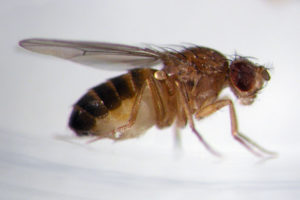Fruit Flies
Adult fruit flies are 1/8-inch long and have a dull, yellow-brown to dark brown color. Some species have distinctive red eyes. The larvae are small (1/10-to 1/5-inch long) and very distinctive with an extended, stalk-like breathing tube at the rear end of the body.
Order/Family
Diptera/Drosophilidae
Scientific Name
Drosophila
Biology
The eggs are laid onto the surface of fermenting fruit or vegetables, or in areas where moisture and yeast are abundant. The eggs hatch within the span of 30 hours. Each female produces up to 500 eggs. The larvae complete development in five to six days and crawl to drier areas of the food or elsewhere in order to pupate. The life cycle (adult to adult) requires eight to ten days.
Behavior
Fruit flies are common structural pests, frequently associated with fermenting fruits and vegetable or excess moisture. Recycling bins and their contents, as well as fruit and salad bars, are ideal habitats and have resulted in increased problems with this pest fly.
Control
Fruit flies are best controlled by finding and eliminating the breeding material. Complete and thorough sanitation is necessary to eliminate the source of the infestation. Insect light traps and baited jar traps, fitted with tops which permit entry and prevent escape, are effective in reducing the population but are no substitute for sanitation.
Need help with Pest Control or Extermination?
Call A to Z Pest Control at 1-844-ATOZPEST or email us at service@atozpest.com.



